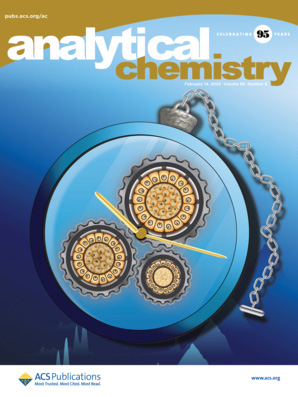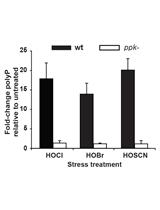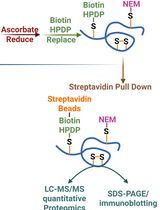- EN - English
- CN - 中文
A New, Rapid Method for the Quantification of Dolichyl Phosphates in Cell Cultures Using TMSD Methylation Combined with LC–MS Analysis
一种利用 TMSD 甲基化结合 LC-MS 分析法快速定量细胞培养物中长链聚异戊烯类磷酸盐的新方法
发布: 2023年11月20日第13卷第22期 DOI: 10.21769/BioProtoc.4880 浏览次数: 1544
评审: Manjula MummadisettiRohit JainBhanu Jagilinki

相关实验方案

适用于 LC–MS/MS 蛋白质组学分析的大体积细胞培养上清分泌组样品制备方法优化
Basil Baby Mattamana [...] Peter Allen Faull
2025年12月20日 1101 阅读
Abstract
Dolichyl phosphates (DolP) are ubiquitous lipids that are present in almost all eukaryotic membranes. They play a key role in several protein glycosylation pathways and the formation of glycosylphosphatidylinositol anchors. These lipids constitute only ~0.1% of total phospholipids, and their analysis by reverse phase (RP) liquid chromatography–high-resolution mass spectrometry (LC–HRMS) is challenging due to their high lipophilicity (log P > 20), poor ionization efficiency, and relatively low abundance. To overcome these challenges, we have introduced a new approach for DolP analysis by combining trimethylsilyldiazomethane (TMSD)-based phosphate methylation and HRMS analysis. The analytical method was validated for its reproducibility, sensitivity, and accuracy. The established workflow was successfully applied for the simultaneous characterization and quantification of DolP species with different isoprene units in lipid extracts of HeLa and Saccharomyces cerevisiae cells.
Keywords: LC–HRMS (LC-HRMS)Background
Dolichyl phosphates (DolP) are long-chain polyisoprenoid phosphates that function as glycan carriers in cellular N- and O-glycosylation, C- and O-mannosylation, and glycosylphosphatidylinositol-anchor biosynthesis (Orlean, 1990; Rosenwald et al., 1990). Numerous studies have reported altered endogenous DolP levels in pathophysiological conditions such as Alzheimer’s disease, dementia, and Prion disease (Kranz et al., 2007; Park et al., 2014; Sabry et al., 2016; Jaeken et al., 2020). Given the essential role of DolP in cellular glycosylation, there is a need for a rapid method to accurately characterize and measure DolP in biological samples, including those from patients with disorders associated with glycosylation defects.
Generally, DolP are quantified after their fluorescence derivatization by combining normal-phase liquid chromatography (LC) with fluorescence detection (Haeuptle et al., 2010). This method, based on a multi-step sample preparation and derivatization procedure, is labor intensive and time consuming. Few mass spectrometry (MS)-based methods exist for the structural characterization of endogenous DolP species (Löw et al., 1991; Wolucka et al., 1996; Guan et al., 2010; Taguchi et al., 2016). To date, a method for the simultaneous profiling and quantification of DolP species of different isoprene chain lengths in biological membranes has been lacking. We have developed a method for the characterization and quantification of DolPs using trimethylsilyldiazomethane (TMSD) derivatization followed by reverse phase (RP) liquid chromatography–high-resolution mass spectrometry (LC–HRMS) analysis. TMSD is frequently used as a methylating agent for anionic phospholipids (Lee et al., 2017) and free fatty acids (Mok et al., 2016) to increase the electrospray ionization efficiency. The scheme of the methylation reaction of DolP is illustrated in Figure 1.

Figure 1. Chemical reaction of trimethylsilyldiazomethane (TMSD)-based methylation of dolichyl phosphates (DolPs). The simplified linear structure of DolP is displayed.
We found that TMSD methylation enabled chromatographic retention of DolPs in RPLC analyses. In the Tandem MS (MS/MS or MS2) analysis of all methylated DolP species by high-energy collisional dissociation, the most intense fragment ion at m/z 127.0155 represents a characteristic headgroup fragment, corresponding to a dimethylphosphate group. Transitions from all parent m/z (Table 1) to 127.0155 in the MS2 spectra were used to determine the identification of methylated DolPs and dodecaprenyl phosphate (PolP C60).
Table 1. Molecular formulas, exact masses, and retention times of [M+NH4]+ of DolP species and the internal standard (IS) PolP C60
| Analyte | Molecular formula | Exact mass [M+NH4]+ | Retention time (min) |
| PolP C60(IS) | C62H103O4P1 | 960.7932 | 19.1 |
| DolP C65 | C67H113O4P1 | 1030.8715 | 20.0 |
| DolP C70 | C72H121O4P1 | 1098.9341 | 20.6 |
| DolP C75 | C77H129O4P1 | 1166.9967 | 21.2 |
| DolP C80 | C82H137O4P1 | 1235.0593 | 21.8 |
| DolP C85 | C87H145O4P1 | 1303.1219 | 22.3 |
| DolP C90 | C92H153O4P1 | 1371.1845 | 22.9 |
| DolP C95 | C97H161O4P1 | 1439.2471 | 23.5 |
| DolP C100 | C102H169O4P1 | 1507.3097 | 24.1 |
| DolP C105 | C107H177O4P1 | 1575.372 | 24.7 |
The established workflow uses a fast and efficient single-step derivatization procedure. Furthermore, the method was used to quantify DolP species from lipid extracts of Saccharomyces cerevisiae and HeLa cells. In the future, this method can be used to study the role of DolP homeostasis in health and disease and how DolP availability may be regulated by microenvironmental factors such as nutrient availability. This method has been thoroughly validated for its quantification utility in Kale et al. (2023).
Materials and reagents
Pipette tips, 50–1,000 μL (Eppendorf, catalog number: 613-3505)
Gastight syringe, 5 mL (Hamilton, catalog number: 81517)
Pipette tips Combitips advanced 25 mL (Eppendorf, catalog number: EP 0030089472)
Round bottom threaded glass tubes (PYREX, catalog number: 9447161)
Pasteur pipettes, soda-lime glass (Brand, Wertheim, Germany, catalog number: 747715)
Micro inserts, Neochrom (Neolab, catalog number: 7-0635)
LC vials, Neochrom (Neolab, catalog number: EC-1184)
Threaded screw caps with Teflon Liner (Corning, catalog number: 9998-15)
Green nitrile gloves (TouchNtuff, catalog number: 92600)
Ammonium acetate (AmAc), eluent additive for LC-MS, LiChropur (Sigma-Aldrich, Merck KGaA, catalog number: 73594)
Formic acid (FA), eluent additive for LC-MS (Honeywell, catalog number: 56302)
Ammonium bicarbonate (Sigma-Aldrich, Merck KGaA, catalog number: 09830)
Acetonitrile, LC-MS grade (Fisher Chemical, catalog number: 10616653)
Methanol, LC-MS grade (Fisher Chemical, catalog number: 10532213)
Isopropanol, LC-MS grade, Optima (Fisher Chemical, catalog number: A461212)
Water, LC-MS grade, Optima (Fisher Chemical, catalog number: 10505904)
Dichloromethane (Sigma-Aldrich, Merck KGaA, catalog number: 270997)
Dolichol 13–21 phosphate mixture (DolP standard hereafter) (Sigma-Aldrich, Merck KGaA, catalog number: 900201X)
Dodecaprenyl phosphate (PolP C60) (CymitQuimica, catalog number: 48-62-1060)
Mini-BeadBeater q mill beads (0.5 mm) (BioSpec Products, catalog number: 11079105)
Potassium hydroxide pellets (KOH) (Sigma-Aldrich, Merck KGaA, catalog number: 21473)
Trimethylsilyldiazomethane (TMSD) (Sigma-Aldrich, Merck KGaA, catalog number: 362832)
Acetic acid ACS grade (Sigma-Aldrich, Merck KGaA, catalog number: 33209)
HeLa/Fibroblast cells (~1 M cells)
S. cerevisiae cells (~0.8 OD)
Acquity UPLC CSH C18 Column, 1.7 μm, 1 mm × 150 mm (Waters, catalog number: 186005294)
Acquity UPLC CSH C18 VanGuard Pre-column, 1.7 μm, 2.1 mm × 5 mm (Waters, catalog number: 186005303)
For the preparation of liquid chromatography, mobile phase A (Solvent A) and mobile phase B (Solvent B), and wash solvents, please see Recipes.
Solutions
15 M KOH (see Recipes)
10 M AmAc (see Recipes)
Solvent A: acetonitrile/water 60:40 (v/v) with 0.1 % FA and 10 mM AmAc (see Recipes)
Solvent B: isopropanol/water 90:10 (v/v) with 0.1 % FA and 10 mM AmAc (see Recipes)
Wash solvent: dichloromethane:methanol:water (3:48:47, v/v/v) (see Recipes)
Dichloromethane:methanol mixture (6.5:5.2, v:v) (see Recipes)
155 mM ammonium bicarbonate buffer (see Recipes)
Recipes
15 M KOH
Accurately weigh 8.4 g of KOH pellets into a 100 mL volumetric flask. Add LC-grade water dropwise with intermittent slow vortex to dissolve KOH. Be careful, as an exothermic reaction will occur, and the reaction flask will be hot. After complete dissolution, dilute the solution to the mark. Use a glass bottle with a PTFE lid for storage of the KOH solution.
10 M AmAc
Take the 10 mL volumetric flask along the glass stopper and rinse both twice with MS-grade methanol. Dry them carefully under Argon. Transfer accurately weighed 7.708 g of LC-MS grade AmAc to the volumetric flask. To dissolve the solid, add distilled water in steps of approximately 100 µL, followed by sonication. Once all solids are dissolved, fill the volumetric flask to the etched line. This stock can be stored at 4 °C for up to six months.
Solvent A: acetonitrile/water 60:40 (v/v) with 0.1% FA and 10 mM AmAc
Prepare 1,000 mL of solvent mixture of acetonitrile/water 60:40 (v/v) and add 1 mL of formic acid and 1 mL of 10 mM AmAc stock. Mix solvent mixture thoroughly and degas for 5 min in an ultrasonic water bath sonicator.
Solvent B: isopropanol/water 90:10 (v/v) with 0.1% FA and 10 mM AmAc
Prepare 1,000 mL of solvent mixture of isopropanol/water 90:10 (v/v) and add 1 mL of FA and 1 mL of 10 mM AmAc stock. Mix solvent mixture thoroughly and degas for 5 min in an ultrasonic water bath sonicator.
Wash solvent: dichloromethane:methanol:water (3:48:47, v/v/v)
Dichloromethane:methanol mixture (6.5:5.2, v:v)
155 mM ammonium biocarbonate buffer
Transfer accurately weighed 1.2 g of ammonium bicarbonate into a 100 mL volumetric flask. Dissolve in distilled water and make up to the mark with distilled water. This stock can be stored at 4 °C for up to six months.
Equipment
Eppendorf Multipette E3 (Eppendorf, catalog number: VB-1748)
Eppendorf Research plus pipette 100–1,000 μL (Eppendorf, catalog number: 3123000063)
Ultimate 3000 LC system (Dionex, Thermo Fisher Scientific) system coupled to a Q-Exactive HRMS (Thermo Scientific)
Vortexer, SI Vortex-Genie 2 (Scientific Industries, catalog number: 15547335)
Nitrogen evaporator (TurboVap, catalog number: 416200)
Syringe, gastight HamiltonTM1700 Series 100 μL (Sigma-Aldrich, MerckKGaA, catalog number: 111HAM201050)
Refrigerated centrifuge, Heraeus Megafuge 16R (Thermo Scientific, catalog number: 75004271)
Ultrasonic water bath sonicator (Bandelin sonorex)
Water bath, LSB Aqua Pro (Grant Instruments, catalog number: LSB12)
Software
XCalibur software 3.2 (Thermo Fisher Scientific)
Online EnviPat R package Tool (available at https://www.envipat.eawag.ch/, Accessed: 21 August 2019)
Procedure
文章信息
版权信息
© 2023 The Author(s); This is an open access article under the CC BY license (https://creativecommons.org/licenses/by/4.0/).
如何引用
Kale, D., Sachsenheimer, T., Sickmann, A. and Brügger, B. (2023). A New, Rapid Method for the Quantification of Dolichyl Phosphates in Cell Cultures Using TMSD Methylation Combined with LC–MS Analysis. Bio-protocol 13(22): e4880. DOI: 10.21769/BioProtoc.4880.
分类
生物化学 > 其它化合物 > 多磷酸盐
生物科学 > 生物技术 > 质谱
您对这篇实验方法有问题吗?
在此处发布您的问题,我们将邀请本文作者来回答。同时,我们会将您的问题发布到Bio-protocol Exchange,以便寻求社区成员的帮助。
Share
Bluesky
X
Copy link











